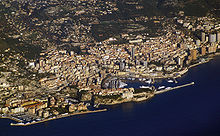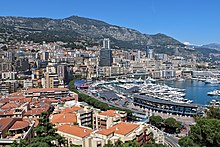Monaco
![]()
This article is about the southern European city state. For other meanings, see Monaco (disambiguation).
Template:Infobox State/Maintenance/NAME-German
Monaco, long form Principality of Monaco (French Principauté de Monaco, Occitan Principat de Mónegue, Monegasque Principatu de Mu̍negu, Italian Principato di Monaco), is a city-state in southern Europe and is located on the Mediterranean Sea. Monaco's form of government is a constitutional monarchy. The state religion is Catholicism. The principality is the second smallest state in the world after Vatican City. Monaco has 38,100 inhabitants (2019) in an area of 2.084 square kilometres (about 208 hectares) and has the highest population density of any state (followed by Singapore and Bahrain), with 18,282 inhabitants per square kilometre. Of the population, 77.5 percent do not hold Monegasque citizenship. The extremely densely populated state is located in the Maritime Alps and on the Côte d'Azur, the French Riviera, near the border with Italy.
Monaco was an ancient trading post of the Phoenicians and later of the Greeks, who built a temple to Hercules here on the northern coast of the western Mediterranean, which was soon nicknamed Monoikos, "single house". When the place became a Roman port, it was given the name Herculis Monoeci Portus, which was shortened to Monaco.
Today, the Principality is a financial centre and is primarily sought after by the world's rich as their main residence, as the city state does not levy income or inheritance tax and does not prosecute tax offences committed abroad. Businesses in Monaco, however, do pay taxes. The state is not a member of the European Union, but is a member of the Council of Europe. Monaco is also a member of the United Nations and the International Organisation of La Francophonie.

aerial view of Monaco

View to the Port Hercule and to Monte-Carlo
Geography
The Principality is located on the French Riviera, at 43° 44′ north latitude and 7° 25′ east longitude between the French city of Nice to the west (13 km away) and the French-Italian border (about ten kilometres away) to the east. The coastal length of the Principality, excluding ports and beaches, is 4856 meters. In recent decades, land reclamation has increased the national territory by more than 40 hectares to 208.4 hectares (2.084 square kilometres). Monaco has a narrow coastal sea area. The entire area of the country lies on the edge of the Maritime Alps.
The only state border is that with the French Republic. The French neighboring municipalities that directly border the city-state of Monaco are (clockwise): Cap-d'Ail, La Turbie, Beausoleil, Roquebrune-Cap-Martin. The length of the state border is 5469 meters. Monaco borders with 1341 meters to Cap-d'Ail, with 390 meters to La Turbie, with 3274 meters to Beausoleil and with 464 meters to Roquebrune-Cap-Martin.
The highest elevation of the French countryside not far from Monaco is the 1148-meter Mont Agel, from which Radio Monte-Carlo used to broadcast. The highest elevation of the Monegasque territory is a good 164.5 meters above sea level in the Jardin Exotique district, while the square in front of the princely palace is 62.2 meters above sea level.
Administration breakdown
The distinction between the state and the city of Monaco is purely theoretical, the state actually consists only of the city (municipality). According to the Constitution of 1911, the Principality was divided into three municipalities:
- Monaco (Monaco-Ville, old town with princely palace)
- Monte-Carlo (Northeast)
- La Condamine (west and north-west with port area Port Hercule)
The reproach to the princely power to proceed according to the saying divide and rule led to the fact that in 1917 the three municipalities were merged into one municipality. The original municipalities were henceforth regarded as boroughs (quartiers).
- Fontvieille was added as a fourth district, which was created from about 1970 onwards in the southwest by reclamation of land from the sea. On the French side opposite is the ZAC (Zone d'aménagement concerté, roughly district development plan) of Saint-Antoine.
- Les Moneghetti was created as the fifth borough by spinning it off from La Condamine.
- Larvotto became the sixth borough by being spun off from Monte-Carlo.
- La Rousse/Saint Roman (with Le Ténao) became the seventh municipality, also through a spin-off from Monte-Carlo.
Subsequently, three more boroughs were created:
- Saint Michel (spin-off from Monte-Carlo)
- La Colle (spin-off from La Condamine)
- Les Révoires (spin-off from La Condamine)
Currently (2021), a new borough called Le Portier, covering an area of 0.275 square kilometers, is being created through further reclamation of new land off the coast of Monte-Carlo. This district is scheduled for completion in 2025.
The territory of the Principality was reorganized by sovereign decree as of September 13, 2013, and since then has comprised nine municipal districts. In general, all boundaries within the Principality have been modified, sometimes slightly, sometimes significantly. In addition, the boroughs Jardin Exotique and Ravin de Sainte-Dévote were newly created. The municipalities of Monaco-Ville and Ravin de Sainte-Dévote are considered "reserved sectors" (Secteur réservé).
| Municipalities of Monaco (since 2013) | |
| Borough | Area in hectares |
| Monte Carlo | 43,7 |
| Fontvieille | 33,0 |
| La Condamine | 29,6 |
| Larvotto | 27,5 |
| Jardin Exotique | 23,5 |
| Monaco-Ville | 19,6 |
| La Rousse | 17,7 |
| Les Moneghetti | 11,5 |
| Ravin de Sainte-Dévote | 2,3 |
| Principality of Monaco (total) | 208,4 |
The boroughs are subdivided into 173 blocks (îlots) for statistical purposes.
They are designated only by four-digit numerical sequences (a two-digit extension of the borough numbers) and do not bear names.
Questions and Answers
Q: What is the population of Monaco?
A: Approximately 39,000 persons live in Monaco.
Q: What language is most commonly spoken in Monaco?
A: French is the most common language spoken in Monaco.
Q: Who is the head of state in Monaco?
A: The Sovereign Prince of Monaco, who is the head of state, is Prince Albert II.
Q: What are some famous car races that take place in Monaco?
A: Two famous car races that take place in Monaco are the Monte Carlo Rally and the Monaco Grand Prix.
Q: How much land has been recovered from the sea since 1980?
A: Approximately 0.4 square kilometres have been recovered from the sea since 1980.
Q: How long is Monaco's coastline?
A: The coastline of Monaco is 4,100 metres long.
Q: How many districts does Monaco have?
A: There are four districts in total; these include Monte-Carlo (the district surrounding its Casino), La Condamine (around Port Hercules), Fontvielle (the new industrial area built on ground reclaimed from the sea) and finally,Monaco-Ville (historic seat of the Principality, on the monolith where the Prince’s Palace stands).
Search within the encyclopedia